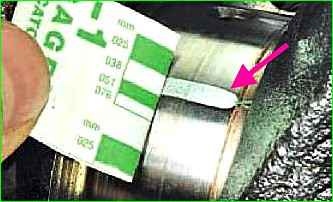Defection and repair of the ZMZ-402 cylinder block of the GAZ-2705
Inspect the block, if there are cracks, replace it
Check the tightness of the cooling jacket of the block; to do this, plug all the holes in the block with wooden plugs, except one, to which connect a hose for supplying compressed air
Lower the block into a bath of water and apply compressed air under a pressure of 1.5 atm.
Air bubbles will escape in areas of leakage. In the same way, check the tightness of the oil passages of the block.
If a leak is detected, the unit must be replaced.
Inspect the cylinder liners.
If there are scratches, burrs, holes, etc. on the cylinder bore, bore the liners to the repair size or replace them.
Two repair sizes of sleeves are provided. Spare parts are supplied with pistons and piston rings with the same repair dimensions.
All liners must be bored to the repair size, even if defects are found in only one.
Check the clearances between the pistons and liners.
The nominal gap should be in the range of 0.024–0.048 mm, the maximum permissible is 0.25 mm.
To ensure the size of the gap, the pistons and liners are divided by diameter into five size groups A, B, C, D and D.
The letter indicating the group of the sleeve is applied to the lower centering part of the sleeve. The clearance can be determined by measuring the diameter of the piston and liner.
The piston diameter is measured in a plane perpendicular to the piston pin axis and 8.0 mm below the pin axis.
The diameter of the sleeve is measured in at least three zones within 15–100 mm from the upper edge of the sleeve, in two perpendicular directions.
When replacing liners, new liners are inserted into the cylinder block so that the letter indicating the liner group is located in the transverse plane.
The sleeve must fit into the block completely freely.

The sleeve installed with a copper gasket in the block should protrude above the surface of the block by 0.02–0.1 mm.
The difference in the protrusion of the liners across the cylinders should be no more than 0.055 mm (this is ensured by selecting the liners according to their length or by settling them with deformation of the copper gasket).
Before removing the sleeves from the block, they must be marked so that during reassembly they can be installed in the same place in the same position as they were before disassembly.
When using old liners, you need to remove the unworn belt in the upper part of the liner, flush with the cylinder mirror.
Size groups of cylinders and pistons
Group "A"
Nominal size:
- - Cylinder diameter 92.036 – 92.024 mm;
- - Piston diameter 92,000 – 91,988 mm
1st repair size *:
- - cylinder diameter 92.536 – 92.524 mm
- - piston diameter 92.500 – 92.488 mm
2nd repair size **:
- - cylinder diameter 93.036 – 93.024 mm;
- - piston diameter 93,000 – 92,988 mm
Group "B"
Nominal size:
- - cylinder diameter 92.048 – 92.036 mm;
- - piston diameter 92.012 – 92.000 mm
1st repair size:
- - cylinder diameter 92.548 – 92.536 mm;
- - piston diameter 92.512 – 92.500 mm
2nd repair size:
- - cylinder diameter 93.048 – 93.036 mm;
- - piston diameter 93.012 – 92.000 mm
Group "B"
Nominal size:
- - cylinder diameter 92.060 – 92.048 mm;
- - piston diameter 92.024 – 92.012 mm
1st repair size:
- - cylinder diameter 92.560 – 92.548 mm;
- - piston diameter 92.524 – 92.512 mm
2nd repair size:
- - cylinder diameter 93.060 – 93.048 mm;
- - piston diameter 93.024 – 92.012 mm
Group "G"
Nominal size
- - cylinder diameter 92.072 – 92.060 mm;
- - piston diameter 92.036 – 92.024 mm
1st repair size:
- - cylinder diameter 92.572 – 92.560 mm;
- - piston diameter 92.536 – 92.524 mm
2nd repair size:
- - cylinder diameter 93.072 – 93.060 mm;
- - piston diameter 93.036 – 92.024 mm
Group "D"
Nominal size:
- - cylinder diameter 92.084 – 92.072 mm;
- - piston diameter 92.048 – 92.036 mm
1st repair size:
- - cylinder diameter 92.584 – 92.572 mm;
- - piston diameter 92.548 – 92.536 mm
2nd repair size:
- - cylinder diameter 93.084 – 93.072 mm;
- - piston diameter 93.048 – 92.036 mm
* 1st repair size increased by 0.5 mm
** 2nd repair size increased by 1.0 mm
Check the gaps between the main bearing shells and the crankshaft bearings, they should be in the range of 0.02–0.073 mm.
The clearances can be calculated by measuring the diameters of the crankshaft journals and journal holes with the main bearing shells and caps installed, or measure them using a calibrated plastic wire. The gaps are measured in the following order:
Clean the crankshaft journals and bearing shells.
Place the crankshaft on the bed of the main bearings with the shells installed.

Place pieces of calibrated plastic wire on the crankshaft journals.
Install the main bearing caps with the liners installed in them
Tighten the cover bolts and tighten to a torque of 100 Nm (10 kgcm). In this case, it is forbidden to turn the crankshaft.

Remove the main bearing caps and, by flattening the wire, determine the gap using the scale marked on the wire package.





